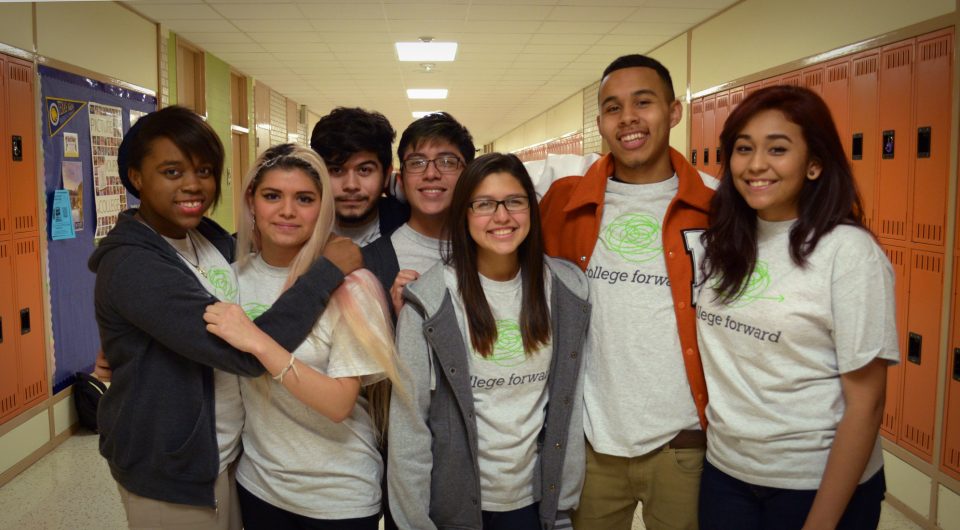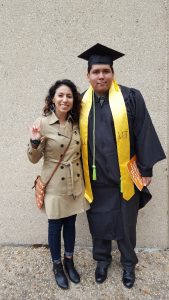
Thanks to the persistence of social entrepreneurs across the country, every day we see strategies that are working and delivering results in a rapidly changing world. This Evidence in Action blog series highlights the voices of the more than 70 social innovation organizations that make up the America Forward Coalition, the results-driven solutions our community has for our country’s most pressing social problems, and the evidence-based federal programs that are critical to scaling the impact of this work. Today we will hear from College Forward about its evidence-based approach to ensuring student success in accessing and completing college.
Cards and cords litter the tables in the College Forward office, as AmeriCorps coaches gather graduation regalia to send to students about to walk across stages and receive their college degrees. Supervising the fray while helping to stuff envelopes is Ashley An, a College Forward Completion Program Manager:
“Graduation really is my absolute favorite thing about the work we do,” she says. “I’m so excited I’m tearing up now!”
Founded in 2003, College Forward coaches motivated underserved students, most of them the first in their family to attend college, on their path to a postsecondary degree. Students are paired with “near-peer” coaches — AmeriCorps members and recent graduates themselves — who support students throughout college: connecting them to campus resources, helping to navigate financial aid issues and deadlines, and offering encouragement along the way.
This spring, 102 students in the program will proudly walk across stages nationwide as new college graduates, joining the ranks of the 736 College Forward alumni who have earned degrees since the organization’s founding.
Paying it forward

Excitement aside, student graduation ceremonies are events that Ashley An takes seriously. Nationally, only nine percent of low-income students receive a bachelor’s degree by age 26, making her work all the more critical. The first in her family to graduate from college, Ashley credits her own experiences at the University of Texas-Austin with propelling her toward her path today: “At the time, I wasn’t aware that I was at a different starting point than many of my peers.” She describes a college journey replete with challenges — academic, financial, and social — that compounded her junior year and eventually resulted in an academic suspension.
“I had to leave UT for the fall semester. I went to [Austin Community College] and took 12 hours and worked two jobs because I lost my financial aid. That was the lowest point for me,” she says. “But I returned to UT the following spring with renewed determination, and still managed to finish in four years (with lots of summer school).”
Ashley’s college experiences fueled her desire to work with students in similar positions: “I chose to work at College Forward as an AmeriCorps member because a coach was exactly what I needed as an undergrad. As a coach, I now had 20/20 vision looking at my college experience, and could use my experiences to help students avoid the mistakes I made, or just simply help them better understand what to expect and embolden them,” she explains. “I felt that for once, my vulnerability as a first-generation student was beneficial, and a positive.”
College Forward’s approach
Beyond “20/20 vision”, at College Forward Ashley had access to a number of tools that informed her work as a coach:
- a college access and completion curriculum that tracked students along key metrics or “milestones”;
- an in-house student information system, CoPilot, that allowed coaches to “flag” students at risk of stopping out, and to use appropriate interventions to prevent this; and
- a robust network of partnerships with local campuses and community-based organizations.
Coupled with near-peer coaches, tools like these have a clear impact: 99% of students in the College Forward program enroll in college, and 83% persist from their first to their second year. Moreover, College Forward students are twice as likely to graduate from college as their demographic peers. From an initial cohort of 30 high school students, the organization has grown into a multi-site operation, partnering with community colleges to serve over 8,000 high school and college students across Texas and the nation.
Scaling student success
After a year in the AmeriCorps program, Ashley became a full-time program manager at College Forward and now supervises a team of seven AmeriCorps college completion coaches, launching a career in higher education and service.
She isn’t the first coach to do so: many AmeriCorps members complete their year of service and accept positions as education advocates, college or career advisors, financial aid counselors, or student support staff at high schools, colleges, and nonprofits nationwide.
The magnitude of this network illustrates College Forward’s loftier goal: ensuring that all students, regardless of income or background, achieve the social and economic benefits of higher education. To accomplish this, College Forward also focuses on actions that impact outcomes on a national scale: mobilizing alumni and student voices into state and federal education policy; licensing the CoPilot information system to other schools and nonprofits; and partnering directly with community college campuses to build out or enhance student success programs. While individual triumphs are key, the organization celebrates them as parts of a broader higher education movement. It’s about more than helping the players – it’s about changing the game.
This post is part of America Forward’s Evidence in Action blog series. Follow along on Twitter with #EvidenceinAction and catch up on the series here.
Leave a Reply
You must be logged in to post a comment.